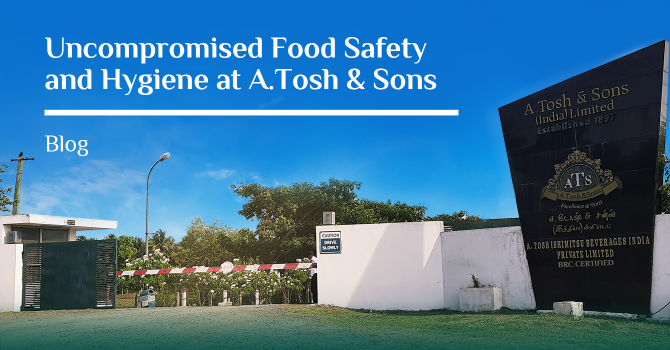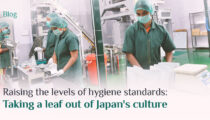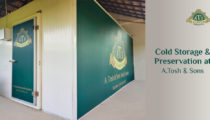Uncompromised Food Safety and Hygiene at A.Tosh & Sons

Across the food industry, all food handling and processing companies have always placed great emphasis on food safety and food hygiene. Any contamination in the food items can have a cascading effect and may affect a great number of people across varied geographic locations. Such an incidence may have a detrimental impact on a business concern. Conversely, good food hygiene practices work towards cementing the goodwill of a business concern, which in turn has a favourable impact on revenues as well.
The recent developments as a result of the Covid19 pandemic have left an indelible mark in history. This unfortunate and unwelcome outbreak has further heightened the importance of food safety, food hygiene, and food defense.
Food safety and food hygiene involve safeguarding all food and related items, including packing material, machinery, and equipment, utilized in the entire packing process from all kinds of contaminants. These contaminants can be broadly categorized as microbiological, physical, and chemical.
The sum total of hygienic practices, food handling processes and related systems is a Food Safety Management System (FSMS). A strong FSMS is fundamental to establishing a strong and reliable brand. The first step towards this begins with proper training of all the personnel involved in the food handling processes. It is imperative that they are sensitized in the importance of food safety and hygiene and that it is absolutely necessary to follow all food safety guidelines in totality.
While cleanliness and hygiene have to be accorded the importance they deserve, a superficial approach does not help in the long run. Instead, the approach should be all-pervading, systemic as well as systematic. At A. Tosh, we ensure food safety and hygiene by implementing the following.
All materials coming into the facility, whether raw materials such as tea, infusions, spices, fruits, flavouring agents, etc., are subjected to inward quality check. Specific standard operating procedures (SOPs) for all functions, including inward quality check.
All the teas processed at our facility are sourced through the e-auction system governed by the Tea Board of India. For any seller to be able to sell their teas in the auction system has to be at least registered with the Food Safety and Standards Authority of India (FSSAI). This pre-requisite not only entails that all the personnel employed at the business concern are educated in the basic food safety regulations, but that the criteria for food safety are met by way of standard procedures and systems. Additional inspections and checks are carried out by the FSSAI from time to time to ensure compliance to the rules and regulations.
Before buying the teas in the auction, our team of experienced Blenders and Tasters evaluate samples and taste thousands of cups of teas in a week before shortlisting the teas. This check also rules out presence of any adulterants such as coloring agents, fillers, etc.
Every single lot of teas sourced from the auction system is subjected to an incoming inspection procedure, which begins from the vehicle in which the teas are transported and continues until a storage space is assigned to each of the bags which are then stored in the right place.
All incoming vehicles are checked to see if the floor bed is covered, there is no foreign material underneath or over the floor cover, there is no taint or uncharacteristic odor, the vehicle is in a clean condition, the load is in a dry condition at the time of receipt, having been covered and secured with a top cover. In addition, all documents pertaining to the tea as well as the incoming vehicle are examined.
All bags are checked at the time of unloading for structural integrity. Additionally, bags are weighed to ensure there has been no tampering with the bags. Subsequently, samples are drawn as per the SOP for each lot for organoleptic examination. This also helps ensure that the teas received are exactly the same as were selected prior to the purchase in the auctions.
Since tea is hygroscopic in nature and can be, therefore, prone to mold formation, an essential check for moisture content (permissible to an extent of 7%) is also performed.
For efficient space management, it is essential that everything has a space and there is a space for everything. Our facility and the layout are designed with this in mind.
We have, at our disposal, a vast storage space – cumulatively 1,80,000 square feet spread over its facilities in Coimbatore and Kolkata. However, segregation of materials according to their nature is quite significant. Therefore, raw material (tea, infusions, spices, fruits, flavours, etc.), packing materials, work-in-progress, rejections/on-hold materials, and finished goods are stored in their respective designated areas. This way any possibility of cross-contamination can be ruled out.
All the incoming tea bags are stored in a clean and dry space, on pallets, and away from the walls. The storage area is cleaned periodically to maintain a hygienic storage condition. Moreover, the stacking of the bags is allowed only to a maximum height of 6’ from the pallet. This prevents any accidental falling of bag, which may result in damage to the bag and thereby possible contamination of the tea.

The insulated ceilings of the warehouse help regulate the ambient temperature and humidity, in addition to minimizing exposure to harsh sunlight.
The specialty teas, such as dessert teas, flavoured teas, infusions, etc., are stored in a temperature-controlled cold room. Work-in-progress teas are stored in a deep freezer which maintains an average of 0 degrees temperature.
For the storage of packing materials, we have a dedicated mezzanine floor spread over an area of almost 7,000 square feet. This area is also access controlled and only limited personnel are allowed into the area. Even in this storage area, different packing materials are kept away from each other.
Second, a unidirectional flow has to be maintained throughout the production facilities. This covers workers, materials, and machinery/equipment. Again, this is quite useful in avoiding cross-contamination.
Only authorized personnel are given access to the production facility. Workers can move in and out of the facility only through electronically controlled doors which are operated by the security personnel using biometric devices.
All visitors to the facility are issued colour-coded Visitor Identification Cards which determine the level of their access to the facility. Additionally, all visitors must submit a self-declaration as it relates to theirstate of health.
In addition to the facility being guarded by security personnel, male and female, we have CCTV cameras and 360 degree view cameras installed at strategic points throughout the premises. The CCTV monitoring system is connected with uninterrupted power supply as well as recording system to ensure 24×7 monitoring and review. Designated staff have access to live monitoring of the CCTV system who are trained to alert for the slightest of suspect/out-of-norms activity.
Additional measures such as double-door entrances, fine mesh nets on windows/ventilators, high-power air curtains have been put in place to allow only authorized access, prevent contaminants (such as dust) and insects (crawling or flying) from entering the processing facility.
Since production activities for the value-added division is carried out in a completely cordoned plant, the material exchange is carried out in an especially designed area which is equipped with interlocking high-speed semi-automatic shutters, fitted with high-powered air curtains and flying insect catcher to avoid all possible contamination.

All entrance points to the facility have an attached hygiene station which cannot be bypassed, and all persons entering the facility must go through and use the hygiene stations. More details on this later.
Being a food processing facility, certain items are classified as prohibited. These include but are not limited to:
- Any food or beverage item, including candies, chewing gum, tobacco, water, bottled/canned beverages, etc.
- Jewelry items including bindis, watches, bracelets, etc.
- Glass items.
- Metal items.
- Plastic items.
- Chemicals.
- Solvents and flammables.
- Perfumes and aerosolized cans.
An extensive list of prohibited items is displayed prominently at every entrance point.
In addition to having proper infrastructure which is geared towards maintaining hygiene, we also have put procedures and training programs in place to ensure good hygiene is maintained on a continuous basis.
As mentioned earlier, every entrance to the facility has an attached hygiene station. In particular, the entrance to the Tea Bag Plant has been thoughtfully designed, aligned to the most stringent Japanese standards.
The area is demarcated into three zones:
Non-Hygiene Area: This includes the restroom facilities. Separate footwear for the restroom facilities are available.
Semi-Hygiene Area: This includes the changerooms and personal locker area (separate for men and women). Again, specific footwear are available for this area. The workers are supposed to change from their personal footwear into semi-hygiene area footwear immediately upon passing through the entrance. The personal protective equipment (PPE) such as hair cap, face mask, and gloves as well as workwear are available in this area.
After this, each worker uses a ‘lint roller’ to remove any loose hair, threads, dust, lint, etc., that may be present on the workwear, before proceeding to the handwash stations.Just prior to proceeding to the handwash station, the workers change into work footwear. Mirrors are also installed for self-checks, to ensure proper cleaning as well as use of proper workwear.

Full Hygiene Area: Subsequent to changing into the workwear and wearing the PPE, the workers proceed to the handwash station. Contactless, sensor-enabled taps and single push soap dispensers are installed at the station. Proper handwash instructions are displayed prominently at each of the hygiene stations. Paper towel dispensers are also available to ensure complete drying of the hands post wash.

As a subsequent step, they must use the hand sanitizer dispenser to completely sanitize their hands up to the wrist before entering the production facility. Again, proper sanitizing technique is prominently displayed alongside each dispenser.

All workers have to make a self-declaration of good health every day. Any worker found to be sick or developing symptoms of any illness is immediately taken off duty and sent back home for proper care. They are allowed back on duty only upon submission of a fitness certificate from a qualified medical practitioner.
Furthermore, the supervisors check every single one of the workers assigned to them for personal hygiene, a record for which is maintained for every working day.
Every worker is taken through the orientation program on their first day which includes sensitization towards Good Manufacturing Practices (GMP), food safety, food defense, personal hygiene, adherence to procedures, and proper use of facilities.
Periodic training programs, including refresher capsules, are conducted as per the Annual Training Calendar. Modifications to this training calendar are made in cases of exigencies such as the most recent Covid19 pandemic outbreak.
Also, training programs of worker safety and hygiene are conducted from time to time in conjunction with the local governing bodies.
Additional pictorial and other information boards are installed at strategic locations that serve as ready-reckoners with respect to the rules, regulations, and standard procedures. These boards are printed in English as well as the local language.

In order to ensure that all the measures listed above culminate in yielding the desired results, it is absolutely imperative to have in-process and post process quality control measures. A testament to our commitment to the highest quality standard is our A Grade certification for BRC Issue 7 in 2019, followed by yet another A Grade certification for BRC Issue 8 this year. For the uninitiated, BRC is considered as the “Gold Standard” by the Food & Beverages Industry at large.
At A. Tosh, we have developed processes and systems that maintain forward and backward traceability. That is to say, for every unit of tea produced at our facility, one can have all the information related to the unit – starting from the garden where the tea was grown and up to the point of sale.
As elucidated earlier, all lots of incoming teas are checked for match against the selected samples. In addition, they are checked for quality and moisture content.
In addition, there are multiple in-process checks conducted at regular intervals that are put in place to ensure that the finished goods meet or exceed the client’s desired quality levels.
For our bulk packing division, prior to blending, the teas are checked against the approved sample by the client. During the blending process, before the teas are packed, the teas from every batch of the blend are checked for conformity to the established standard.
Additional checks have been put in place to check for markings on the tea sacks, structural integrity of the overall packaging, and finally the net content per package.
For the value-added division, the number of checks increase by manifold owing to the many different parts involved in the entire packing process. Again, as mentioned earlier, every item that comes into the facility goes through a series of qualitative and quantitative checks.
The online quality checks (in-process checks) ensure that every unit produced adheres to all the established quality parameters. These include but are not limited to:
- checking of packing material – conformity to design/color, dimension, GSM, weight, strength specifications
- checking of in-process packing – conformity with the net weight, contents per unit, gross weight, quality of product/packaging as well as avoidance of damage, taint, etc.
- checking of markings on the packaging – conformity with date of packaging, date of expiry, other relevant markings.
Furthermore, we conduct frequent offline quality checks. At a pre-determined interval, the Quality Control Team randomly selects from the finished goods to test against all the factors set out for that particular type of packing.

Also, in order to maintain food safety, as part of the Food Defense Program, access to the hopper area (from where the blended teas are fed into various machines) is restricted to very few authorized personnel. Furthermore, every movement to and from the hopper area is recorded, along with the reason.

Throughout its 123-year-old history, A. Tosh has had the distinction of being one of the rare few companies that have had zero customer complaints and one of the highest customer retention rates – all this thanks in no small measure to our adherence to our tenets of ‘Excellence’ and ‘Trust’.
The state-of-the-art infrastructure, skilled as well as experienced professionals, and most importantly, the highest standards of food safety and hygiene have been instrumental for us in attaining the highest level of customer satisfaction and retention. Our commitment to innovate and staying ahead of the curve within the industry has held us in good stead over the years. Last but not the least, our various certifications bear proof to our exceptional competence and our passionate efforts.




